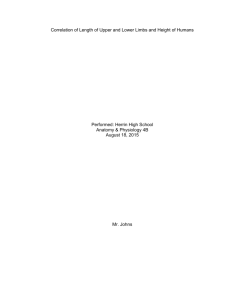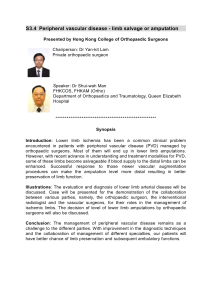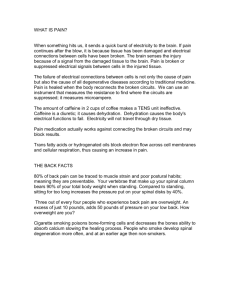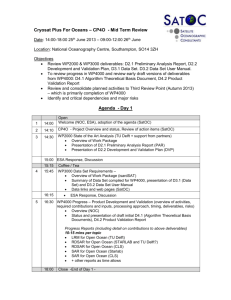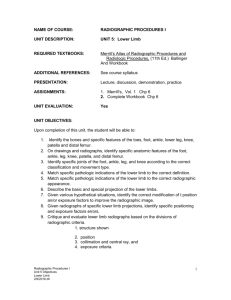Minutes - sciamachy
advertisement
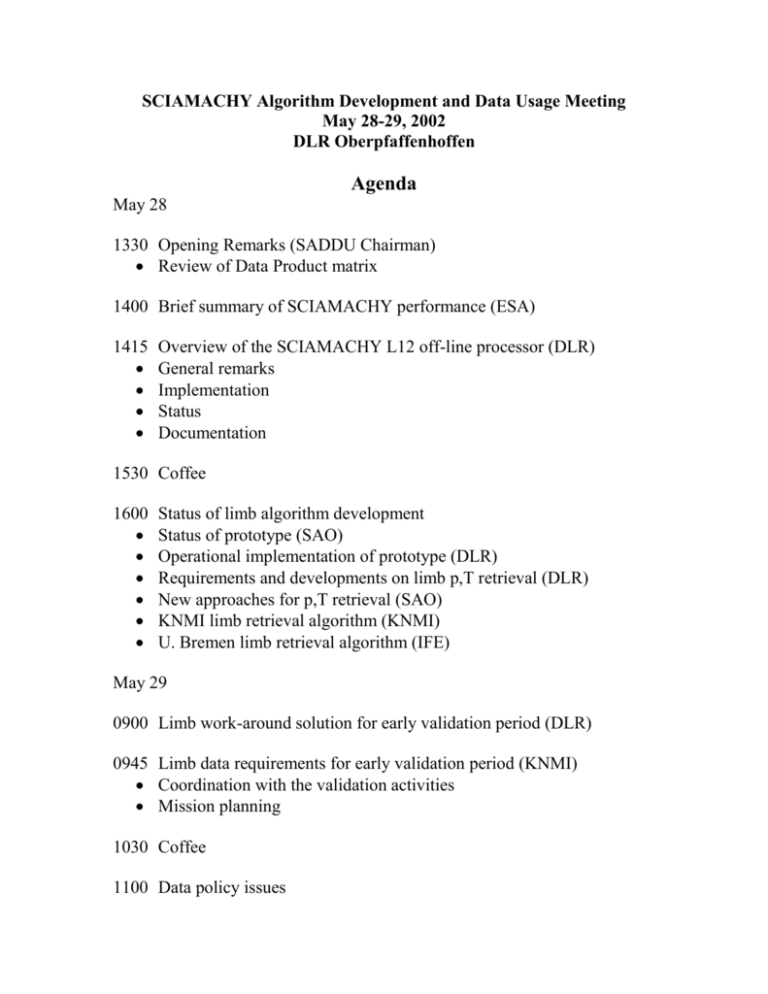
SCIAMACHY Algorithm Development and Data Usage Meeting May 28-29, 2002 DLR Oberpfaffenhoffen Agenda May 28 1330 Opening Remarks (SADDU Chairman) Review of Data Product matrix 1400 Brief summary of SCIAMACHY performance (ESA) 1415 Overview of the SCIAMACHY L12 off-line processor (DLR) General remarks Implementation Status Documentation 1530 Coffee 1600 Status of limb algorithm development Status of prototype (SAO) Operational implementation of prototype (DLR) Requirements and developments on limb p,T retrieval (DLR) New approaches for p,T retrieval (SAO) KNMI limb retrieval algorithm (KNMI) U. Bremen limb retrieval algorithm (IFE) May 29 0900 Limb work-around solution for early validation period (DLR) 0945 Limb data requirements for early validation period (KNMI) Coordination with the validation activities Mission planning 1030 Coffee 1100 Data policy issues ESA data policy for L1, L2, and higher products (ESA) Agency data policy for L1, L2, and higher products (DLR, NIVR) Publication during validation period (SAO) Operational versus scientific data products (SAO) 1200 Lunch 1330 Availability of data for algorithm validation (ESA, DLR) 1400 Commissioning phase algorithm refinements (SAO) 1430 Algorithm updates - examples and discussion (ESA) GOME Data Processor V3 Upgrade - User Consultation, Decision Process, Implementation, Validation, Results 1500 AOB Proposal for SCIAMACHY data inventory (SAO) Time and place of next meeting (All) Attending: Kelly Chance Albrecht von Bargen Hans Schrijver Ahilleas Maurellis Klaus Bramstedt Christian Muller Johannes Frerick Claus Zehner Wolfgang Balzer Andreas Richter Johannes Kaiser Tom Rother Sander Slijkhuis Ankie Piters Jeroen van Gent Piet Stammes Achim Friker SAO DLR-IMF SRON SRON IFE/IUP Bremen B.USOC-BIRA-IASB ESA-ESTEC ESA-ESRIN DLR-MF IUP Bremen IUP Bremen DLR DLR-IMF KNMI KNMI KNMI DLR-RD-RE +1-617-4957389 +49-8153-282742 +31-30-2538728 +31-30-2535745 +49-421-2184584 +32-2-3730372 +31-71-5655457 +39-06-94180544 +49-8153-281893 +49-421-2184474 +49-421-2184352 +49-8153-281404 +49-8153-281412 +31-30-2206433 +31-30-2206799 +31-30-2206449 +49-228-447397 Action Items kchance@cfa.harvard.edu albrecht.von-bargen@dlr.de h.shrijver@sron.nl a.n.maurellis@sron.nl klaus.bramstedt@iup.physik.uni-bremen.de christian.muller@oma.be johannes.frerick@esa.int czehner@esa.int wolfgang.balzer@dlr.de richter@iup.physik.uni-bremen.de johannes@uni-bremen.de tom.rother@dlr.de Sander.slijkhuis@dlr.de piters@knmi.nl gentjvan@knmi.nl stammes@knmi.nl Achim.friker@dlr.de S. Slijkhuis: make a narrow-swath proposal to the SOST team, to be sure we have enough information from different scan strategies to later consider optimizing scanning strategy (June 17). A. Piters: Send SCIAVALIG and NILU protocols to J. Frerick. (June 17.) J. Frerick: Check that protocols and ESA requirements are consistent. (June 24). W. Balzer and J. Frerick review the list of software tools on the validation website for possible update. (June 24). K. Chance: email A. Richter, A. von Bargen, W. Balzer with current understanding of the process for algorithm refinement during commissioning phase. (June 17). K. Chance: Determine why the absorbing aerosol index implemented for SCIA is different from the TOMS AAI algorithm. (Closed – the DPM has been updated to show that they are the same). All: Provide suggestions to K. Chance for the form and content of a SCIAMACHY data inventory for scientific use. (Next SADDU meeting). Minutes Review of Data Product matrix It is noted that the cloud algorithm implemented for launch is the DLR OCRA cloud fraction. No aerosol algorithm has yet been proposed except for the UV TOMS-type absorbing aerosol index (AAI) which has been implemented now for several years. The current OL Data product matrix is available with these minutes. Brief summary of SCIAMACHY performance J. Frerick presented an overview of SCIAMACHY performance (presentation available with these minutes): SCIAMACHY is, so far, “fully functional,” but problems with the Envisat Payload Module Computer (PMC) have delayed the full SCIAMACHY turn on. At this time, no l1b data have yet been processed and disseminated and there is thus also no l2 data available. 0-1 parameters are now fixed and we should be ready for the next data, when the satellite is back up. The hope is that the final door will be open and that there will be l1b data in June. Overview of the SCIAMACHY L12 off-line processor Both OL and operational support are done with DLR (Oberpfaffenhofen) internal funding. NRT 0-1 and 1-2 processing is supported through the route DLR-Bonn → ESA → NRT developer. The 1-2 OL operational baseline for O3 is GDP version 2.4, with data input from version 2.7, except FM spectra, which are from SCIA (ready July 1). Other nadir UV/vis products are also ready July 1. Limb UV is ready November 30. Prototypes that will be ready November 30 include GDP 3.0, PTH limb, and the line-by-line code for limb. Status of limb algorithm development Wavelength windows for limb measurements are currently expected to change over three pressure height regimes. For limb ozone measurements the current default is the use of the SCIA FM cross sections, over the 20-45 km range (at least at the start) and (variable) wavelength windows in the 320-360+ nm range. There are lots of trials of the limb algorithm for ozone at DLR, using the 0-1b prototype processor to generate “calibrated” radiances and fitting to limb scan ratios. The trials include comparisons to the DLR NGONG algorithm. Fitting so far, for cloud-free (Sahara) scenes gives ~1% rms values. Q: Do we have enough information from different scan strategies to later optimize scanning strategy? A: S. Slijkhuis should make a narrow-swath proposal to the SOST team. K. Chance presented a summary of the off-line algorithm prepared by R. Spurr (available with these minutes). K. Chance presented the knee algorithm developed for OSIRIS and modified for SCIAMACHY by C. Sioris, now of the SAO. J. van Gent presented the KNMI/SRON SCIARALI radiative transfer model for SCIAMACHY limb. It is estimated to be ca. 2 months from working. The presentation is available with these minutes. J. Kaiser presented IFE/IUP progress in limb algorithm development (presentation available with these minutes), which includes both the SCIATRAN/CDIPI and SCIARAYS radiative transfer approaches and retrievals by three different methods. Limb work-around solution for early validation period As the first limb algorithm is not scheduled for operational implementation until November 30, 2002 and the validation measurements start substantially before that (in fact, this summer) it has been necessary to produce a “limb work-around” (LWO) procedure, whereby limited limb products will be produced by hands-on work with the limb prototype. The LWO products are not “official” data products. It is estimated that the implementation of the LWO will require ~5 FTE weeks of work, starting in early July and finishing by August 1. 5 FTE weeks is only an estimate, based on preliminary knowledge of the minimum necessary limb data products for early validation (the actual amount is highly correlated to the number of orbits to be processed by hand). SCIAVALIG will send a list of states to DLR, which will then revise the estimate of labor for preparation to run the LWO products. The focus will be on O3 and NO2, with CH4 perhaps eventually also being produced (although this was thought by some to be very unlikely). It was not clear whether the estimated 5 FTE weeks of effort would impact the November 30 operational target date by a similar amount (DLR estimates that the limb target date will be affected by a similar amount). Limb data requirements for early validation period K. Bramstedt presented an overview of early validation activities for which such data will be necessary between July and October (presentation available with these minutes). C. Muller noted that 26 July is the nominal commissioning date, although that is now likely to change with delays due to the PMC. J. Frerick noted that the minimum requirement for commissioning is that SCIA is operational and taking data, rather than successful processing at first. It is more a case of “verification” than “validation.” A. Piters inquired about the possibility to process the preliminary data products with different algorithm and input parameter settings and make these available to the validation scientists. Validation scientists can aid in the fine tuning of the algorithm parameters, by comparing their measurements with SCIA data processed with different parameters. S. Slijkhuis answered that this should in principle be possible. Data policy issues C. Zehner gave a presentation on ESA data policy (available with these minutes). He reiterated the categories of users: Category 1 – Research (free products) Category 2 – Commercial ESA does not currently plan to produce any level 3 data products. The list of users is available at http://projects.esa-ao.org. It is now possible to apply for Category 1 status at any time (as opposed to the past requirement to respond to an AO). Currently, AO responders receive data free, including production costs; outside the AO it may be necessary to pay production costs (although the Program Board may decide to make them totally free). A. Piters asked about the procedure for new cal/val proposals. C. Zehner replied that in principle the deadline has passed, but individual cases might be included in the cal/val when it is considered to be essential. (E. Attema notes that after the commissioning phase and after the transfer of the mission to from ESTEC to ESRIN the ACVT structure will survive for at least another 9 months.) Category 1 data users are not restricted from producing and distributing their own L2 data, except that distribution must be limited to other Category 1 users if an ESA product also exists. J. Frerick states that publication (including web sites, conferences and meetings) during the commissioning and validation periods should be cleared in advance through G. Levrini and E. Attema of ESA. A. Piters argued that all AO PIs have signed several protocols in which these issues are cleared. She does not recall needing “prior written permission” from ESA for publication, although of course proper acknowledgements and copyright statements are required. She will send the NILU, SCIAVALIG, and ESA protocols to J. Frerick, who will check into the situation. (Question from the chair: do they require “prior written permission” from SCIAVALIG and/or NILU?) E. Attema suggests in reviewing the minutes that if there is any problem with protocol inconsistency, the ESA one be used because of its contractual significance. C. Muller noted that the Belgians plan to use the Netherlands data center for re-distribution (with ESA permission). C. Zehner noted that the AO countries (DE, NL, BE) can re-distribute data to anyone within their own country. The FODP is not yet signed. At issue is who gets what data under what conditions, particularly whether there would be an agreed list versus informing ESA after the fact. The Netherlands is willing to re-distribute data products to other countries when required, and with ESA's approval. Algorithm development, new SCIAMACHY products New data products are highly encouraged (A. Friker) but may take substantial time to implement (P. Stammes, with the example of the FRESCO cloud algorithm, which is at DLR but is not implemented). P. Stammes asked what funding is available for such upgrades. (FRESCO is P4 – peer-reviewed, published, publicly-available, and in the processor!) OL updates get a Δ-validation NRT updates get a δ-validation Also on the topic of validation, W. Balzer noted that DLR validates algorithms with a test data set as part of the verification process. A. Piters stated that scientific development of SCIAMACHY algorithms, in parallel to the operational algorithm improvement, is essential for the scientific output of SCIAMACHY. The validation groups will be encouraged to participate in the validation of such products. A. Friker noted that some of the longer-term validation funds were used up by the extended pre-launch. C. Muller Noted that ESA has no chemistry mission scheduled for the next 10 years. Envisat could be requested to be the GMES “big project.” Availability of data for algorithm validation J. Frerick noted that data are currently limited to the Kiruna orbits. This will eventually improve. Ground rules during this commissioning period are defined by the ESA GSOCP document. W, Balzer, in collaboration with J. Frerick, will maintain a website to enter results, objectives, tasks, etc. A small amount of l1b data will initially be made available through the ATMOS website (button below SOST) – perhaps 1 or 2 orbits worth (A. Richter suggests one orbit with both continents and ocean); this will come after the instrument I fully operational and will use a nominal orbit state. The date for this will be end of June to mid-July (in late June the in-flight calibration auxiliary files for 0-1b processing may or may not be done). LWO limb data will also be made available on the ATMOS web server. A. Richter asked in which format the lv2 limb off-line product will be provided to the validation groups. J. Frerick answered that the format will be the ENVISAT PDS format, but that EnviView does not currently support this specific format. He added that, to his knowledge, implementation of the lv2 limb off-line products into EnviView is currently not foreseen. A. Richter pointed out, that supplying data in a complex format without tools to convert it to standard formats (ASCII, HDF, NetCDF,...) is not acceptable, and that validation groups will not be able to develop PDS reading tools on their own. Therefore, without a data conversion tool, validation of the lv2 limb off-line products will not be possible. W. Balzer noted that he has written a LINUX tool to convert the limb off-line products to ASCII format, and that he is willing to provide it to the validation groups with the data. It was agreed that implementing lv2 limb off-line products into EnviView has a high priority, in order to facilitate SCIAMACHY data usage by the scientific community. (This point was also stressed post-meeting by other scientists.) W. Balzer and J. Frerick are requested to review the list of software tools on the validation website for possible update. Commissioning phase algorithm refinements A. Richter proposes that minimization of χ2 and reduction of artifacts as found in GOME be primary criteria for optimization of fitting. We will spend about a month or less optimizing, after first getting the test orbits. Choices will apply to both OL and NRT. The timing is a bit tricky; the September 9-13 commissioning phase review is very late to optimize the fitting; however, the final flight states are only determined at the end of SODAP (end of July), and at least a few weeks are needed to optimize and verify the baseline choices. The goal is to finalize the algorithm baseline by September 9, just before the SODAP and commissioning phase reviews. K. Chance will email A. Richter, A. von Bargen, and W. Balzer with his current understanding of the process for algorithm refinement during commissioning phase. Algorithm updates - examples and discussion A. Piters showed a viewgraph from the FODP on the Change Control Board. C. Zehner have a presentation on “GOME Data Processor V3 Upgrade User Consultation, Decision Process, Implementation, Validation, Results” as an example of the update process (available with these minutes). It was generally acknowledged that at least one year will be required to implement algorithm improvements, although many would prefer faster implementation. Any Other Business P. Stammes presented a sensitivity study on aerosols, and asked why the absorbing aerosol index implemented for SCIA is different from the TOMS AAI algorithm. K. Chance took an action to investigate. T. Kurosu proposes that there be a data inventory for SCIAMACHY users, containing such useful information as geolocation, time, measurement mode, for convenient lookup of desired data products. DLR has something similar now on the web from B. Aberle, and J. Frerick also has something. A group action was set to suggest what should go into an improved inventory. Time and place of next meeting October 8/9, 2002 at RAL



